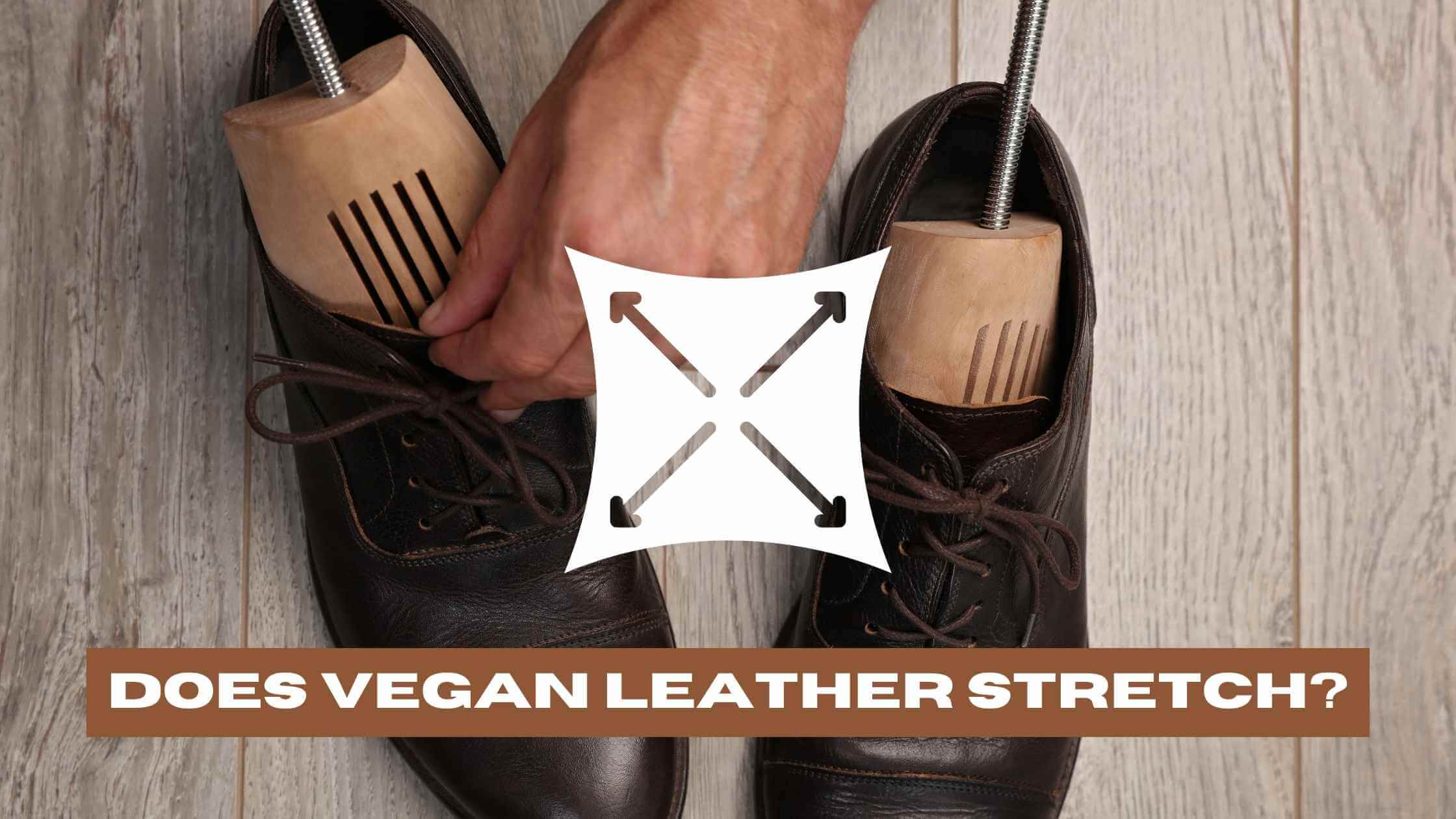Vegan leather has become increasingly popular in recent years as a more ethical and sustainable alternative to traditional leather. However, there are still many questions surrounding the material, including whether it has the same properties as real leather.
Yes, vegan leather can stretch to some extent, but it is generally less stretchy and pliable than real leather. Proper care and use, including wearing and conditioning, can help increase its flexibility over time.
While vegan leather does have some similarities to real leather, it is important to understand that it is not the same material. This means that it may not have the same stretch and durability as real leather. However, there are still many benefits to using vegan leather, including its affordability, versatility, and eco-friendliness.
Key Takeaways:
- Vegan leather, also known as faux leather or synthetic leather, is a popular alternative to traditional leather made from a variety of materials including cork, pineapple leaves, apple peels, and plastic, with the most common types being polyurethane (PU) and polyvinyl chloride (PVC).
- Vegan leather can stretch, but not to the same degree as traditional leather, and it’s important to care for it properly to maintain its flexibility. Regular wear, as well as use of leather stretching sprays, can help increase its stretchability.
- While vegan leather is often more durable than traditional leather and resistant to water, stains, and scratches, it is generally less durable than real leather. However, with proper care and maintenance, it can still have a long lifespan.
- The production process of vegan leather is more environmentally friendly than that of traditional leather, using fewer resources and producing less waste. However, the environmental impact can still vary depending on the materials used to make the vegan leather.
- Vegan leather products can be softened and distressed to make them more comfortable and to give them a unique, worn-in look. Techniques include using a leather conditioner, applying heat, or using sandpaper or a wire brush to distress the surface.
- Vegan leather is a great option for those seeking a more ethical and sustainable alternative to traditional leather. It’s widely available, comes in a variety of styles and colors, and offers similar style and comfort to real leather products.
- Not all vegan leather is created equal. The quality, durability, and longevity of vegan leather can vary significantly depending on the specific materials and construction methods used, so it’s important to choose high-quality vegan leather products.
What is Vegan Leather
If you’re considering purchasing vegan leather, it’s important to know what it is and how it’s made. Vegan leather is also known as faux leather, non-animal leather, or synthetic leather. It’s a popular alternative to traditional leather, which is made from animal hides.
Vegan leather is made from a variety of materials, including cork, pineapple leaves, apple peels, and plastic. The most common types of vegan leather are made from polyurethane (PU) and polyvinyl chloride (PVC). PU leather is made by coating a fabric with a layer of polyurethane, while PVC leather is made by coating a fabric with a layer of PVC.
Fun Fact: One fun fact about vegan leather is that it's often more durable than traditional leather. It's also more resistant to water, stains, and scratches. Vegan leather is available in a wide range of colors and textures, so you can find the perfect option to match your personal style.
The production of vegan leather is also more environmentally friendly than traditional leather production. Traditional leather production involves the use of chemicals and a lot of water, which can be harmful to the environment. Vegan leather production, on the other hand, uses fewer resources and produces less waste.
Does Vegan Leather Stretch?
If you’re considering buying vegan leather, you may be wondering if it has the same stretchability as real leather. The answer is yes, vegan leather does stretch, but not as much as real leather.
Faux leather is thinner and less pliable than real leather, so it’s more likely to crack when stretched too far. However, with proper care and maintenance, you can increase the stretchability of your vegan leather items.
The best way to stretch vegan leather is to wear it frequently. As you wear it, the material will begin to conform to your body, becoming more comfortable and flexible. You can also try using a leather stretching spray, which can help soften the material and make it more pliable.
It’s important to note that not all vegan leather is created equal, and some types may stretch more than others. For example, synthetic leather made from polyurethane (PU) tends to be more flexible than leather made from polyvinyl chloride (PVC).
If you’re unsure about how much a particular vegan leather item will stretch, it’s always a good idea to try it on before purchasing. This will give you a better idea of how the material will feel and how it will fit over time.
Durability and Longevity
When it comes to durability, synthetic leather, including vegan leather, is generally less durable than real leather. However, that doesn’t mean that vegan leather can’t last a long time with proper care and maintenance.
One factor that affects the durability of vegan leather is wear and tear. Like any material, vegan leather can become worn and damaged over time with regular use. However, some synthetic leathers are designed to be more durable than others. For example, polyurethane (PU) leather is often more durable than polyvinyl chloride (PVC) leather.
Another factor that can affect the longevity of vegan leather is the quality of materials used in its construction. Higher-quality materials are generally more durable and longer-lasting than lower-quality materials. When shopping for vegan leather products, look for items made with high-quality materials and construction.
To extend the lifespan of your vegan leather items, it’s important to take proper care of them. This includes regular cleaning and conditioning, as well as avoiding exposure to extreme heat or cold. Additionally, storing your vegan leather items in a cool, dry place can help prevent damage and prolong their lifespan.
Production and Materials Used
When it comes to vegan leather, there are a few different materials that can be used in production. While some vegan leathers are made from natural materials like cork, kelp, apple peels, and pineapple leaves, many are made from synthetic materials.
Two commonly used synthetic materials in vegan leather production are polyurethane (PU) and polyvinyl chloride (PVC). PU leather is made by coating a fabric base with a layer of polyurethane, while PVC leather is made by coating a fabric base with a layer of PVC.
While vegan leather made without synthetic materials is more eco-friendly, it is important to note that not all synthetic materials are created equal. For example, PVC leather is made from plastic and can release harmful chemicals during production and disposal.
When comparing vegan leather to traditional leather, it is important to consider the environmental impact of both materials. Traditional leather production requires large amounts of water and energy and often involves the use of chemicals like chromium. Vegan leather, on the other hand, can be made without these harmful chemicals and with less impact on the environment.
Softening and Distressing Vegan Leather
If you’ve just purchased a new pair of vegan leather shoes or a jacket, you may find that the material is stiff and uncomfortable. Fortunately, there are ways to soften and distress vegan leather to make it more comfortable and give it a more worn-in look.
One of the best ways to soften vegan leather is to use a leather conditioner. There are many vegan leather conditioners available on the market that are specifically designed to soften and moisturize the material. Simply apply the conditioner to the surface of the material and use a soft cloth to gently rub it in. Be sure to follow the manufacturer’s instructions for best results.
Another method to soften vegan leather is to use heat. You can do this by using a hairdryer on a low heat setting and directing the warm air towards the material. This will help to loosen up the fibers and make the material more pliable. Be sure to move the hairdryer around to avoid overheating any one area.
If you’re looking to give your vegan leather a distressed look, there are a few techniques you can use. One method is to use sandpaper to scuff up the surface of the material. This will create a rougher texture and give the material a more worn-in appearance. Be sure to use a fine-grit sandpaper and work slowly to avoid damaging the material.
Another method is to use a wire brush to create scratches and scuffs on the surface of the material. This will create a distressed look that is similar to what you would see on a well-worn leather jacket. Be sure to use a light touch and work slowly to avoid damaging the material.
FAQ: Does Vegan Leather Stretch?
Does vegan leather stretch?
Yes, vegan leather can stretch to some extent. However, it does not have the same level of elasticity as real leather.
What is vegan leather?
Vegan leather is a synthetic alternative to real leather that is made from materials such as plastic or fabric backing coated with polyurethane (PU) or polyvinyl chloride (PVC).
How is vegan leather made?
Vegan leather can be made using various materials and methods. Some common types of vegan leather include PU leather, PVC leather, and microfiber leather. These materials are often produced by layering a fabric backing with a synthetic surface.
What is the difference between vegan leather and faux leather?
The terms “vegan leather” and “faux leather” are often used interchangeably. Both refer to synthetic alternatives to real leather that do not involve the use of animal products. However, “vegan leather” generally implies a higher quality and durability compared to “faux leather.”
Is vegan leather better than real leather?
The answer to this question depends on personal preferences and values. Vegan leather is generally considered more sustainable and ethical, as it does not involve the use of animal products. However, real leather may have certain desirable qualities, such as natural aging and patina development.
Can vegan leather be as durable as real leather?
Yes, high-quality vegan leather can be just as durable as real leather. However, the durability may vary depending on the specific type and quality of the vegan leather.
Are vegan leather shoes a good alternative to real leather shoes?
Vegan leather shoes can be a great alternative to real leather shoes. They offer similar style and comfort without using animal leather. However, it’s important to choose high-quality vegan leather shoes to ensure durability and longevity.
What are the different types of vegan leather?
Some common types of vegan leather include polyurethane (PU) leather, polyvinyl chloride (PVC) leather, microfiber leather, and cork leather. These materials offer a range of textures and appearances.
How does vegan leather compare to real leather?
Vegan leather and real leather differ in terms of production methods, materials used, and properties. Vegan leather is synthetic, while real leather comes from animal hides. Real leather may be more breathable and develop a natural patina over time, whereas vegan leather is often more water-resistant and easier to maintain.
Does faux leather stretch like real leather?
Faux leather does have some stretch, but it is generally less stretchy than real leather. The elasticity of faux leather depends on the specific quality and composition of the material.

